A thorough guide on the history of dog domestication. From why & how we domesticated dogs, to the effects of dog domestication today.
Introduction

Dogs have long been known as man’s faithful best friend.
As a dog myself, I can assure you that we are, by far, the most popular pet in the United States, with an estimated 63.4 million households owning a pet dog in 2019-2020. (In your face, cats!)
It is hard to imagine a world without us as your loyal companions, and no matter where you are in the world it is likely that you would have at least some experience with a pet dog, whether you have one yourself or you have a friend or family member that does.
However, this has not always been the case. Us dogs have not always been pets. Dogs were once wild animals (and I can vouch for the fact that many of us still behave like wild animals…).
It took a process of domestication to make us the trusty companions you know and love today.
So, what is it that got us the moniker ‘man’s best friend’? What changed to make wild animals accustomed to a more luxurious life as a companion of humans?
In this article I will be exploring the reasons why dogs were domesticated, looking at the history of it, trying to figure out when exactly domestication occurred, and exploring the effects of dog domestication on both humans and dogs.
So if you have wondered about how your beloved dog came to exist, or if you have noticed some striking similarities between your dog and a wild animal and wondered whether they may be related somehow, then this is the article for you.
Why Were Dogs Domesticated?

Historically, dogs were used as tools to help early humans get on with their daily lives. That is not to say they were treated badly and used, but instead, they had a purpose beyond being a mere companion.
The partnership between humans and dogs was likely to be one of necessity rather than friendship or equal living. Humans needed dogs to help with hunting and herding, thus the relationship between the two species was formed.
Dogs helped humans by providing help when hunting and gathering food, and humans helped give dogs protection and a regular food source.
This is one of the theories given for the domestication of dogs – that they were used by humans to help with hunting. However, another theory is related to wolves and their relationship with humans.
Many experts think that as far back as the Ice Age, humans would share their surplus meat with wolves, which are descendants of dogs.
They often had more meat than they could eat themselves, and so sharing it with animals such as wolves would have been the next best option.
The theory is that the sharing of food with wolves got them more used to being around humans. As wolves became more accustomed to people, they would have slowly been more susceptible to being domesticated.
It has been very difficult to prove exactly why the relationship between dogs and humans began, but given what we know about the situation during the Ice Age, it seems that rather than being competitors, wolves and humans worked together.
They did this thanks to humans allowing wolves to eat their surplus meat, and humans providing protection for wolves. It is even thought that humans took in orphaned wolf cubs if their parents died.
They may have done this at first with no long term goal in mind, but likely found that, as the wolves matured, they were domesticated enough to keep as companions, but still possessed the skills to help them hunt and gather.
It is likely that these adopted wolf cubs would have been fed on that same excess meat that was discussed earlier in the section, and it has been proven by expert Maria Lahtinen and colleagues that there was certainly more than enough meat to go around, at least in the harshest winters.
Lahtinen and colleagues have also stated, however, that there may not have been enough meat for the whole year round to keep wolves completely tame and domesticated.
That being said, even having them for a few months at a time meant that they would not be in competition for resources over the long winter months.
These partly domesticated wolves can be seen as ‘proto-dogs’, according to Lahtinen, and can be used as early examples of the tame, domesticated dogs that we know and love today.
The reason why still remains uncertain, but as is suggested from the research of Lahtinen and others, it was likely to be a relationship of necessity and a way of ensuring there was no competition over resources.
The research on the purpose of dogs in these times also supports the use of dogs as ‘gun dogs’ much later in history.
Gun dogs were trained to help with hunters in much more recent history, and it seems that, in many ways, the early domesticated dogs led the way for this, with the dogs of today still possessing the same instincts and traits as the early proto-dogs in terms of hunting.
When Did Humans Start To Domesticate Dogs?
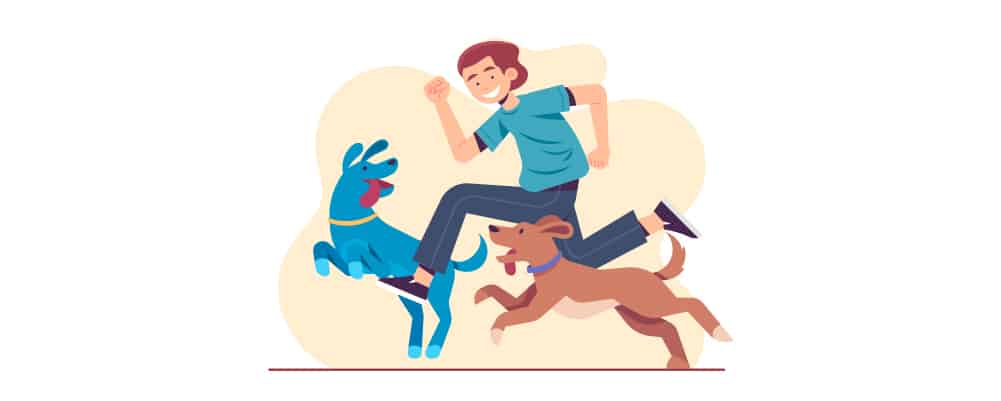
In the previous section, we drew attention to the importance of wolves in forming the relationship between humans and dogs.
Of course, wolves are not quite dogs, and it is thought that the split between dogs and their wolf ancestors happened around 27,000 years ago, with some experts stating that it may have happened even earlier than that, some 40,000 years ago.
This also aligns with the theory about when dogs first started to become properly domesticated. With this in mind, it is clear that the theory of dogs becoming domesticated in the period of the Ice Age has some truth behind it.
As you will know from the previous section, it is unlikely that the humans of the Ice Age period would not have had enough resources to keep these early dogs for a whole year, but it is highly likely that they kept them for months at a time during the harsh winters.
This would have led to wolves becoming tamer, turning into what we call ‘proto-dogs’, and then eventually becoming dogs as we know them today.
This was a long process, especially when considering that wolves, the direct ancestors of dogs, were once one of the most feared animals in existence. However, over time, they became our ’closest domestic partner.
The domestication of wolves and dogs is nothing short of extraordinary when you consider the fact that, for most of the year, wolves were a competitor of humans in the Ice Age.
However, even with the masses of support for the Ice Age theory, there is still much in the way of disagreement over the exact time that dogs become domesticated.
We have fossilized evidence of dogs existing some 10,000 years ago, and some from a little earlier, 14,000 years ago.
These dates coincide with the rise of agriculture, now, the rise in agriculture has long been associated with the domestication of other animals, and so it is known for sure that dogs were domesticated at this time.
However, other evidence suggests that the domestication of dogs was far earlier, as we will know by the theory about the domestication of wolves in the Ice Age.
Of course, the last Ice Age was long, beginning over 2.6 million years ago, and only ending just under 12,000 years ago. With this in mind, stating that the domestication of dogs dates back to the Ice Age does not really help anyone.
It is vague, and more specific detail is needed. This specific detail can be found in the form of fossilized evidence, and thankfully, there has been some evidence found in the form of a fossil.
This fossil is a skull that is thought to prove the existence of early dogs, and it pushes the date for the domestication of dogs back even further than the 10 to 14,000 years that is also theorized.
The skull that was found dates back to 33,000 years ago. Whilst it does not totally prove that the domestication of dogs began then, it does suggest that there was a hybrid wolf-dog in existence then.
Of course, it is not quite a dog in the way that we know them, but it does share characteristics with modern dogs and wolves. It is a skull with a short snout and very large teeth.
This affirms the possibility of a partly domesticated wolf – an early domestic dog!
With all these dates flying around – 10,000 years ago, 14,000 years ago, and even 33,000 years ago – it can be very difficult to confirm once and for all when humans began to domesticate dogs.
Suffice to say that experts cannot confirm any of these proposed time frames for sure.
This begs the question of whether the domestication of dogs was one event or a number of different events. What we mean by this is that there may have been a number of different instances of domestication.
This could have happened thanks to a number of different events. For example, the finding of the 33,000 year old skull (this happened in Siberia) was found to have some mitochondrial DNA links with Newfoundlands, Siberian Huskies, and Tibetian Mastiffs.
These links were not perfect matches by any means and showed more of a close resemblance than an exact match.
For this reason, it is hard to confirm whether the 33,000 year old skull belongs to an ancestor of these dogs, or if the animal 33,000 years ago merely became extinct.
Extinction may have happened to many wolf-dog hybrids, which would suggest multiple wolf domestications being possible.
Again, this is difficult to confirm or deny at the moment, but it is certainly a possibility that this happened many times throughout history, in many different parts of the world.
This tells us that, rather than there just being one example of dog domestication that led to all of the breeds of dogs today, there were multiple domesticated wolf-dogs, leading to the plethora of breeds of dogs that we have today.
Another theory related to the finding of this 33,000 year old skull is that the domestication of dogs began at the very site the skull was found – the Altai Mountains in Siberia.
Some theorists have been led to believe that the domestication of wolves into dogs here may have led to the geographic spread of the animals in other parts of the world, particularly in Asia and Europe.
This contradicts beliefs that the domestication of dogs happened 12,000 years ago in Israel, or in East Asia around 15,000 years ago.
As you can see, there are many theories over when exactly dogs became domesticated, all with very compelling evidence.
It seems to us that the domestication of dogs may actually have happened a number of different times before finally becoming the domestication that we know today.
How Were Dogs Domesticated

In this article so far, we have explored some of the cultural reasons as to why dogs were domesticated and looked at when this may have happened.
As you will know by now, given the vast time periods that we are working with, it can be difficult to confirm for certain when and why dog domestication occurred.
So, with this in mind, we are going to be using this section to look at how dogs were domesticated. This section allows the use of science, namely biology to give an explanation as to why dogs came to be, having evolved from wolves.
One thing that remains a fact is that dogs are direct descendants of wolves. That’s right, your cute little Dachshund and your neighbor’s huge, loveable Rottweiler come from the same ancestor.
Hard to imagine, isn’t it? But it is true enough, with wolves being known as Canis lupus, and dogs being given the name Canis lupus familiaris.
The domestication of dogs is due to the evolution of wolves into dogs. What we mean by this is, it is because of the early domestication of wolf cubs by humans through the harsh Ice Age winters that we have the dogs we know today.
The two events needed to happen together. In even more simple terms, wolves needed to be domesticated to turn into dogs, leading to the overall domestication of dogs as we know them today.
Not all wolves would have been accustomed to humans. They were competitors of humans as both of them needed animal protein to survive.
They would have been hunting the same animals. Anyone who has seen a wild wolf will know that they are to be feared. This was the same in the hunter-gatherer eras.
However, it is not unthinkable that there were ‘friendlier’ wolves who became acquainted with humans when they ate their leftover meat.
This put them in a prime position to strike up a necessary friendship with humans who could provide them with food when resources were more difficult to come by.
And, as we know, this led humans to treat these wolves as a sort of domesticated pet, taking in orphaned wolf cubs to feed and keeping them as help for hunting.
Of course, as time progressed, these occurrences likely became more common, with wolves gradually evolving into a prototype of the dogs we know today.
Over time they would have lost many of their recognizable wolf characteristics and developed shorter snouts.
It is, therefore, partly thanks to the consumption of meat that we have dogs today. What we mean by this is that wolves were likely domesticated by humans because of their shared need for animal protein as a way of survival.
Humans often had a surplus of meat because they needed other food sources to survive. The meat was readily available, and so any leftover waste that they had was up for grabs.
This resulted in them sharing it with wolves, and, in turn, led to wolves becoming more accustomed to being around humans.
Without this need for meat, wolves may not have made this connection with humans, and we may not have dogs today.
The Effects Of Dog Domestication

There are numerous effects of the domestication of dogs that we can see in the dogs that we know and love today.
Dog domestication has benefited humans in more ways than we perhaps ever thought possible. They have provided protection, companionship, helped us hunt, and have even been a symbol of status.
In this section of the article, we will be exploring all of the different effects of dog domestication and whether it has benefited us as humans.
Socialization
 Dogs of today are social little things.
Dogs of today are social little things.
As we mentioned right at the start of the article, they have long been known as man’s best friend.
This didn’t just happen overnight of course and is partly due to the fact that they stem from wolves.
Wolves, like humans, are highly social creatures.
They live in packs and form very strong social bonds within their groups. Since wolves were domesticated by other very social groups, humans, it seems obvious that the resulting evolution of the dog will also be very social.
This could also be the reason why humans and dogs form such a close social bond.
Attachments are important for both humans and dogs, and so it makes sense why socialization is such a key aspect as to why dog domestication has worked so well.
All animals have a period that is known as the socialization period. It is within this time that the important bonds between their fellow animals (and other animals) are made. For wolves, this is around 6 to 8 weeks.
This means that young wolves can have up to 8 weeks where they can form attachments with one another. After this time the fear response can begin to kick in, resulting in them having a far harder time creating a bond.
In dogs, the socialization period is a little longer. It tends to happen between the ages of 5 weeks and 12 weeks. This means there are a possible 12 weeks in which a dog can form a bond with another dog or any other animal.
In fact, many sources actually theorize that the socialization period can last up to 20 weeks. In this time period, it is very important that a puppy is introduced to as many humans and other dogs as possible.
This should always be done safely, with the supervision of yourself (or the dog owner). A puppy should never be left alone with another animal.
Pleasant and positive interactions with any human that will be spending time with the puppy in the course of its life is vital.
It is equally important that, if you have other family pets, or they will be spending time with any other animals from a different household, that you introduce them from a young age.
Doing these introductions too late in the life of a puppy could mean that socialization is never formed.
The reason why it is important to socialize your dog in this period is that, after this, their own fear response can kick in, thus making attachments harder to form.
This longer period of time for which socialization can take place can make it far easier for puppies to form a relationship with a human.
Over time, because dogs spend more time with humans than other dogs, their socialization periods past 5 weeks are taken up with forming a connection with their human caretakers, and you will see that the affection a dog shows is directed towards a human far more than it is towards other dogs.
In fact, it is very common for dogs to display a fear response towards other dogs.
If you have a dog that has not yet been socialized and they are past the recommended age, it is still possible but may be much more difficult.
Your dog could have anxiety around both animals and humans because their fear response has kicked in before they have been able to form bonds. Socializing an older dog requires patience, love, and care.
Social Structure
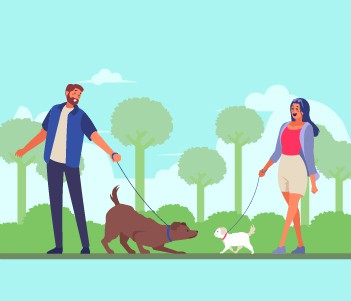 Linked to the section above we have the effect of social structure.
Linked to the section above we have the effect of social structure.
As we mentioned previously, wolves exist in packs. Within a pack, there are typically two alphas (a male and female).
There will also be other members of a pack that can be looked at in a similar way to a human family.
There will be a litter, along with other adult wolves such as aunt, uncles, and cousins. This is similar to the social group of a dog.
If dogs were left to reproduce in the wild, it is likely that they too will form a pack. However, as we know, dogs are largely a domesticated bred, and so, their ‘pack’ varies slightly.
The pack of a domestic dog will be made up mostly of humans, and may also include other dogs and animals. Because of their evolution, dogs will naturally have a dominant element in their DNA.
In some dogs, this is more pervading than others. However, because of their domestication, they also have subordinate traits that tend to overshadow any dominance they have.
Because of their subordination, dogs are easy to train, thus making them fantastic house pets. In contrast, a wolf in the wild would be almost entirely dominant, especially any alpha wolves, thus being untrainable.
That being said, that does not mean that wolves need to be written off as aggressive. In fact, even with their dominance, they also regularly partake in subordination in relation to members of their own pack.
Because of the pack mentality of wolves, they know that it is far more beneficial for them to work together for better chances of survival and to hunt better.
This means that they try to resolve intergroup conflict in a way that will not injure members of their own group. This is actually different from domesticated dogs.
Because domesticated dogs typically have no reason to work and cohabit with other dogs for means of survival, they do not hold the same subservience towards dogs as they do humans.
This can lead to aggressive behavior amongst dogs whilst they attempt to assert their dominance over another dog.
This has meant that dogs often try to assert their dominance over other dogs (especially stranger dogs) for no apparent reason and without being antagonized first.
So whilst the domestication of dogs has helped them to become more inclined to listen to humans, allowing them to become subordinate rather than dominant, this can mean that they are more aggressive to other dogs.
Of course, because of how easily dogs can be trained in comparison to other animals, you can teach a dog to show subordination to other dogs.
For example, if you notice your dog getting territorial from a young age when they are around strange dogs, and see that they show signs of wanting to dominate or act aggressively, you can train this out of your dog, and even seek advice from a veterinarian or dog behavioral specialist.
Reproductive Potential
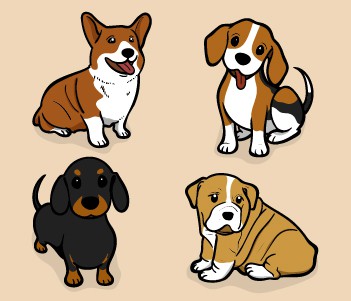 One effect of the domestication of dogs that needs to be discussed is the way it has impacted the reproductive potential of the animal.
One effect of the domestication of dogs that needs to be discussed is the way it has impacted the reproductive potential of the animal.
Dogs have a much longer window for reproductive ability than that of wolves.
They become sexually mature much faster and are thought to have more chances for reproduction each year in comparison to that of wolves.
In a pack of wolves, it is thought that social and sexual maturity occurs alongside one another. This happens between the ages of 18 months and 24 months.
In dogs, things have evolved differently. Dogs actually reach sexual maturity before they reach social maturity.
Sexual maturity can happen from 6 to 9 months, meaning a female dog can have a litter before they even reach one year of age.
They do not actually reach social maturity until much later, at 24 months. This means that dogs are sexually mature for more of their lives than wolves.
The reason for this could be one of many, but it is likely related to the fact that dogs were bred quickly by humans in order to get their desired breed and characteristics.
Enhanced reproductivity in dogs has meant that offspring can occur in the shortest amount of time possible.
The factor behind this that we can use to compare wolves and dogs is that of the estrous cycles of the female. In wolves, it is thought that females only have around one cycle a year. This is typically in the springtime.
Dogs, on the other hand, can have two cycles per year, and they are not solely in one season. Male wolves will only produce sperm when the female dogs are having their cycle.
This means that they can only produce sperm in springtime. As such, offspring are produced seasonally. In contrast, male dogs produce sperm year-round, and so puppies can be born at any time of year.
Another effect of domestication of sexual reproduction is that of litter sizes. Dogs can, in general, produce a bigger litter than wolves. This does, of course, depend on the breed in question.
For example, a pug is not likely to yield a bigger litter than a wolf. However, a big dog such as a Great Dane or Rottweiler may be able to produce more pups than a wolf.
As well as this, the fact that they could possibly have two litters a year compared to just one in wolves means that the production of dogs is faster than that of wolves, at least in theory.
Factors that may affect this include neutering of dogs by humans, and not allowing dogs to mate.
Reproductive abilities were desired to be greater because of how popular the breeding of certain types of dogs became in the Victorian era.
It is actually said that most of the dog breeds of today are thanks to the breeding that occurred in the Victorian era.
In fact, until the Victorian era, dog breeds did not exist. Prior to 150 years ago, dogs were seen as a necessity for working, hunting, protection, and companionship.
This changed in the English Victorian era, and soon the rest of the world followed suit. Keep on reading to the next section to find out why this was.
Desirable Characteristics
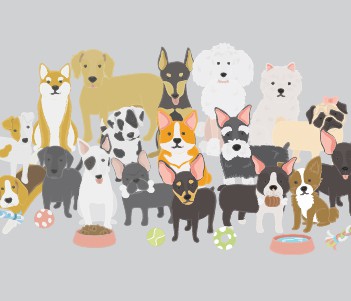 When selective breeding was in its prime in the Victorian era, dogs were made to have litters as often as possible, in quick succession.
When selective breeding was in its prime in the Victorian era, dogs were made to have litters as often as possible, in quick succession.
The late 1800s saw the rise of dog competitions where it was desirable for dogs to fit a certain standard.
This is where we saw the beginning of breed standards come to light which told people how a certain breed should look and what characteristics they should have.
Dogs were starting to be desired more for their looks and less for their abilities as working dogs, companions, or protectors.
This was catapulted even further with the creation of Kennel Clubs, especially due to the desire of having purebred or pedigree pups.
The domestication of dogs made this possible. Regardless of the species, whenever an animal undergoes an evolution into domesticity, there will undoubtedly be changes in its physical and behavioral characteristics.
As we know, dogs became less like wolves and developed obedience that their wild ancestors did not have.
However, their physical character changed too. Their teeth remained mostly the same just getting smaller and fewer in number, but their faces changed.
Their snouts became shorter, their ears longer, their coats smoother, and their tails waggier (we know that isn’t a word but let us have it!).
Of course, as we now know, humans were the main reason behind these changes in that they would breed dogs until they got their desired characteristics.
All you have to do is look at photos of a Boston Terrier from 100 years ago and compare it to a Boston Terrier now and you will see just how much influence humans have had on the breeds of dogs.
This is not always a good thing. Using the example of the Boston Terrier again, the breeding of them to have a flatter, ‘more attractive’ face has led to many health problems for them, such as respiratory issues, hip dysplasia, being more prone to skin infections, and even risk of earlier death than the same breed 100 years ago.
The same has happened to pugs.
These animals were bred to look good, but have ended up with deteriorating health as a result. Some dogs have changed so dramatically that they are barely recognizable now compared to the same breed 100 years ago.
Poodles, for example, have evolved from having long thick coats that resembled strands of hair to thick, fluffy, and curly fur.
Whilst these changes in domesticated dogs may seem purely for the selfish needs of humans who want them to look a certain way, it helps the dog to survive and thrive, too.
If a dog is more desirable to a human then it will not need to be adapted into the wild. The human will keep the dog, giving them a home and keeping them as a companion because they are pleasant to look at, touch, and be around.
Domesticated dogs have also kept some of the features that wolves lose when they reach maturity. For example, whilst young wolves whine to communicate with their parents, adult wolves rarely whine.
Dogs, on the other hand, have evolved to keep these juvenile wolf habits as a way of communicating with humans. This benefits the dog as they can get the attention they need from the human providing their care.
Other
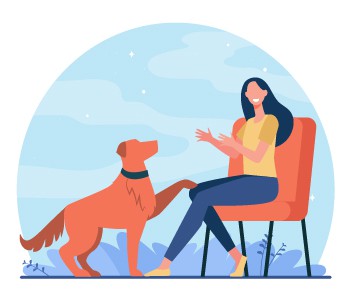 One other effect of the domestication of dogs that deserves some thought is the fact that dogs have become a companion to humans in a way that many other animals have not.
One other effect of the domestication of dogs that deserves some thought is the fact that dogs have become a companion to humans in a way that many other animals have not.
As we have said many times already, dogs have become known as ‘man’s best friend’, and it is easy to see why.
Of course, dogs are still used for purposes such as hunting, farming, and protection, but these days the most common job of a dog is simply to be a family pet.
Dogs these days, as a result of domestication, are viewed as a member of the family.
As if that wasn’t enough, dogs can actually help to improve our health and our lives. They provide comfort to humans and have been able to help humans overcome their issues.
For example, dogs can be trained to help blind and deaf people. Service dogs can be used for war veterans and sufferers of PTSD and other mental health issues. Dogs can be paired with lonely people who have no living companions.
Dogs can even be trained to help someone who suffers from seizures. They know how to recognize a seizure, sometimes before it even happens, and can alert attention to their human companion so that they can get help.
The good that a dog can do for us humans is astronomical, and it is certain that, without domestication, this may never have happened.
So, it seems that those wolves, all those thousands of years ago were a good judge of character when they formed a partnership with our human ancestors.
Their simple act of sharing food resources in harsh winters has led us to the dog companions that we have today!
Summary

To summarize, the history of the domestication of dogs is a long one.
What we now know for sure is that dogs have evolved from wolves, and whilst the exact era of domestication is unknown, many theories support it occurred up to 33,000 years ago. Dogs may have been domesticated more than once.
The dogs that we know and love today are all related to wolves (as hard as that connection may seem for some dogs), and whilst selective breeding and human interaction has made them look a million miles from the wolf, the fact remains that wolves once befriend humans, and dogs remain man’s best friend to this day.
Thanks for reading!